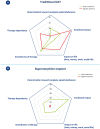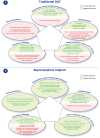The experience of buprenorphine implant in patients with opioid use disorder: a series of narrative interviews
- PMID: 37720906
- PMCID: PMC10501400
- DOI: 10.3389/fpsyt.2023.1205285
The experience of buprenorphine implant in patients with opioid use disorder: a series of narrative interviews
Abstract
Background: This study used narrative medicine (NM) to assess the point of view of patients with opioid use disorder (OUD) and the impact that addiction and a new treatment approach via buprenorphine implant had on their daily lives as compared with previous oral Opioid Agonist Therapy (OAT).
Methods: Five patients with OUD undergoing treatment with a buprenorphine subcutaneous implant participated voluntarily and provided their anonymity by self-describing, in response to questions prompted by the clinician, their experience with this innovative therapy. The narratives were analyzed according to standard NM methodology. Citations of patients' positive or negative experiences with traditional OAT and buprenorphine implant were classified according to five categories-patient's determination toward complete opioid abstinence, emotional impact, impact on life, smoothness of therapy, and therapy dependency-and quantified to obtain a picture of the overall therapy experience.
Results: The analysis revealed the extent of the burden not only of addiction but also of the traditional OAT on patients' life, including relationships with family, job management, and free time. Conversely, the therapy with buprenorphine implant revealed a significant improvement in the quality of life of the patients, who also largely reported a positive emotional outcome during this therapy, as well as a solid determination to achieve complete recovery.
Conclusions: This study illustrates the complex problems of living with OUD and provides insights into the added value of an innovative buprenorphine implant therapy that, due to its administration route and prolonged duration, allows patients to take an additional step toward total opioid abstinence and complete recovery of daily life.
Keywords: buprenorphine implant; narrative medicine; opioid agonist therapy; opioid use disorder; quality of life.
Copyright © 2023 Scurti, Nunzi, Leonardi, Pierlorenzi, Marenzi and Lamartora.
Conflict of interest statement
The authors declare that the research was conducted in the absence of any commercial or financial relationships that could be construed as a potential conflict of interest.
Figures


References
-
- World Drug Report 2022 . United Nations : Office on Drugs and Crime. Available online at: //www.unodc.org/unodc/en/data-and-analysis/world-drug-report-2022.html (accessed June 14, 2023).
-
- The The Diagnostic and Statistical Manual of Mental Health Disorders 5th ed . Available online at: https://www.apaservices.org/practice/reimbursement/icd-diagnostic/dsm-5 (accessed June 14, 2023).
-
- Cozzolino E, Faillace G, Falcone G, Leonardi C, Lucchini A, Somaini L, et al. . Raccomandazioni intersocietarie sul trattamento della dipendenza da oppiacei. Patient and Clinical Practice (2021). Available online at: https://www.patientandclinicalpractice.com/anno-iv-numero-2-2021/ (accessed August 22, 2023).
LinkOut - more resources
Full Text Sources

